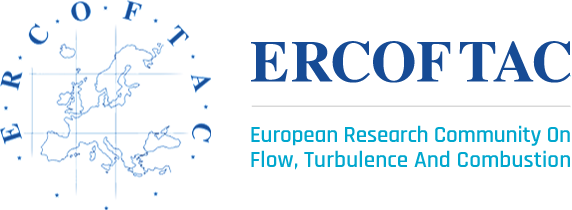ERCOFTAC PC Belgium
The Pulsing Wind Turbine Wake
Marion Coquelet
(Institute of Mechanics, Materials and Civil Engineering, UCLouvain, Louvain-la-Neuve, Belgium; Delft Center for Systems and Control, TU Delft, Delft, the Netherlands)
The video shows the volume rendering of the vorticity field in the wake of a wind turbine operated with the Pulse control to enhance wake recovery by periodically varying its thrust [1]. The video highlights the evolution of the pulsing perturbation as it is advected downstream. One can observe the variations of near wake expansion and tip vortex pairing location (blue), the emergence of a coherent bulge (lavender blue), its development into a vortex ring (purple), and its gradual breakdown due to the generation of small turbulent structures (pink). This simulation stands out for the wide range of scales it captures in the Pulse wake, offering unique insights into the mechanisms enhancing wake recovery. The simulation was performed on a 400-million-point grid using the Large-Eddy Simulation solver VPM, developed at UCLouvain [2]. It ran for 8 days on 2048 CPUs (400kCPUh) on the LUMI supercomputer.
[1] Munters & Meyers. Wind Energy Science, 2018. Towards practical dynamic induction control of wind farms: analysis of optimally controlled wind-farm boundary layers and sinusoidal induction control of first-row turbines. https://doi.org/10.5194/wes-3-409-2018
[2] Chatelain, Backaert, Winckelmans & Kern. Flow, turbulence and combustion, 2013. Large eddy simulation of wind turbine wakes. https://doi.org/10.1007/s10494-013-9474-8
Scientific Abstract
Active Wake Mixing for Wind Farm Power Optimization: from Small-Scale Tip Vortex Instabilities to Large-Scale Structures in the Wake
M. Coquelet (Institute of Mechanics, Materials and Civil Engineering, UCLouvain, Louvain-la-Neuve, Belgium; Delft Center for Systems and Control, TU Delft, Delft, the Netherlands);
M. Duponcheel, DG. Caprace, P. Chatelain (Institute of Mechanics, Materials and Civil Engineering, UCLouvain, Louvain-la-Neuve, Belgium)
JW. van Wingerdenb (Delft Center for Systems and Control, TU Delft, Delft, the Netherlands)
Introduction: Reducing wake effects in wind farms is crucial for the wind energy sector. Active wake mixing, which refers to control techniques that limit wake losses for downstream turbines by actively enhancing wake recovery through rotor actuation, has sparked interest in the last years [1,2].
Objective: This work aims at bridging the scale gap from previous numerical studies [2,3] by providing simulations resolving both the tip vortex instabilities and the far wake dynamics. We focus on two active pitch control strategies, the Pulse [1] and the Helix [2], and analyze their impact on the wake.
Methodology: Large-Eddy Simulations (LES) are performed using a Vortex Particle-Mesh method in which blades are modelled as Immersed Lifting Lines [4]. Simplified wind conditions, i.e. uniform inflow with a 1% turbulence intensity, are used to isolate the effect of the controllers. Simulations are performed for the Pulse (periodic variation of the collective pitch angle) and the Helix (periodic variation of the individual pitch angles) strategies [1] and compared against a Baseline control case.
Results: We first determine the appropriate grid resolution for our study. We show that, from a resolution of 128 grid points per rotor diameter, the pairing instability of tip vortices is consistently observed, and wake statistics, such as mean wind speed and turbulent kinetic energy, are converged. We then highlight the impact of the Pulse and the Helix on both the small-scale structures (circulation of the tip vortices and onset of the pairing instability), as well as the large-scale ones (wake expansion and displacement/meandering). We also highlight that power gains leveraged by the Pulse and the Helix are sensitive to the grid resolution, with an overestimation trend at coarser resolutions.
Conclusions: This work uses high-resolution LES to investigate the impact of active wake mixing techniques on wake dynamics. The 3D flow field visualization is the first step in observing the effect of the rotor actuation on the wake. For the Pulse (the case presented in the video), it shows how the dynamic changes in thrust affect near-wake expansion, leading to the formation of bulges that evolve into vortex rings, which are eventually broken down by smaller structures. After observation, the next step is quantification. The simulations have emphasized that capturing the pairing instability ensures consistent quantification of wake recovery. They have also taught us that attention should be paid to resolution when quantifying the gains that could be leveraged by active wake mixing in wind farms.
Acknowledgements: We acknowledge LUMI-BE for awarding this project access to the LUMI supercomputer, owned by the EuroHPC Joint Undertaking, hosted by CSC (Finland) and the LUMI consortium through a LUMI-BE Regular Access call.
References
[1] Munters & Meyers. Wind Energy Science, 2018. Towards practical dynamic induction control of wind farms: analysis of optimally controlled wind-farm boundary layers and sinusoidal induction control of first-row turbines.
[2] Frederik, Doekemeijer, Mulders, and van Wingerden. Wind Energy, 2020. The helix approach: Using dynamic individual pitch control to enhance wake mixing in wind farms. https://doi.org/10.1002/we.2513
[3] Brown, Houck, Maniaci, Westergaard, and Kelley. AIAA Journal, 2022. Accelerated wind-turbine wake recovery through actuation of the tip-vortex instability. https://doi.org/10.2514/1.J060772
[4] Chatelain, Backaert, Winckelmans & Kern. Flow, turbulence and combustion, 2013. Large eddy simulation of wind turbine wakes. https://doi.org/10.1007/s10494-013-9474-8
